We have just started to carry a new brand of wine yeast that we are very excited about.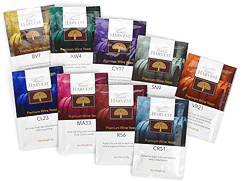
For years we have offered the standard Red Star and Lalvin brands of yeast in little, active dried packets. We later started to carry liquid wine yeast because many of our customers wanted the better selection of yeast strains that the liquid brands offered.
But the biggest issue with liquid yeast is the price. Many of our customers do not want to pay the price required to bring liquid wine brewing yeast to market even though they very much like the specific yeast strains offered.
Now, there are no more issue. We have a brand of wine yeast that can make everybody happy. It’s called Vintner’s Harvest. This brand offers nine premium strains of yeast, similar to liquid yeast, but in active dried pouches so the price can be kept down to a reasonable level.
Each of the 9 yeast strains come in 8 gram packets good for fermenting up to 8 gallons of homemade grape wine or fruit wine. We have just put up a yeast strain chart on our website to shows what each type of yeast is best suited for fermenting.
Next time you decide to make a batch of homemade wine, try one out and see what you think. Once you know what kind of wine you’re making, just go to the yeast strain chart and pick out the best strain of wine yeast for the job.
———————————————————————————————————
Ed Kraus is a 3rd generation home brewer/winemaker and has been an owner of E. C. Kraus since 1999. He has been helping individuals make better wine and beer for over 25 years.
What's In A Wine Ingredient Kit?
Wine ingredient kits offers a great way to make wine when grapes are not in season. These kits contain all the ingredients you will need to produce a batch of wine, as long as you already have the equipment. But what is exactly in one of these kits?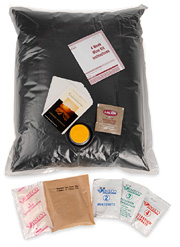
The first thing you should know is that the grapes used to produce these kits are not just any grape from any vineyard down the road. These homemade wine kits contain grape juices collected from notable vineyard regions around the world: France, Italy, South Africa, Australia, New Zealand and, yes, California to name a few.
These kits also come with the wine yeast, fining agents, oak chips (if needed) and in most cases wine bottle labels–customized with the type of wine, alcohol percent, etc. The wine yeast is what does all the fermenting; the fining agents helps to clear the wine; and the oak chips give the wine a natural, barrel-aged flavor.
Another big advantage to making wine with these ingredient kits is that they come with directions that are specific to what you have in front of you. No guessing. The homemade wine instructions make life easy.
So take a look at the ingredient kits that we offer. There are over 200 to choose from: red, white, sweet, dry. There’s one to suite everyone’s taste.
———————————————————————————————————
Ed Kraus is a 3rd generation home brewer/winemaker and has been an owner of E. C. Kraus since 1999. He has been helping individuals make better wine and beer for over 25 years.
What To Get The Lil' Ol' Wine Maker In Your Life
Looking for something to get that lil’ ol’ wine maker in your life? We understand that you don’t know a thing about making wine, and that’s why we’re here to help. Give us a call or send us an email, and with a few simple questions we’ll help you pick out the perfect personalized wine gift.
Some ideas for wine making gifts might be one of our wine making ingredient kits. We offer over 200 different wine making juices collected from all around the world. They come packaged with the yeast and all the other little packets of ingredients they might need.
Another idea might be items that help make bottling homemade wine easier. A Bottle Tree might be just the ticket. This item makes sanitizing and draining wine bottles a much easier task.
If all else fails, we still have gift certificates for any denomination you like. They can be purchased by phone and mailed to you the same day. Just let us know, and we’ll do everything we can to make sure your lil’ ol’ wine maker gets the wine making gifts he needs.
———————————————————————————————————
Ed Kraus is a 3rd generation home brewer/winemaker and has been an owner of E. C. Kraus since 1999. He has been helping individuals make better wine and beer for over 25 years.
Speed Things Up With A Grape Destemmer
When making wine from grapes there’s one piece of homemade wine equipment that you may want to consider, the grape destemmer. A grape destemmer can greatly speed things up by processing the grapes automatically instead you doing them by hand.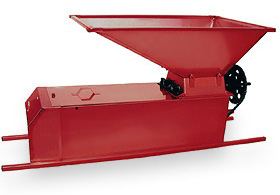
The grape destemmer crushes the grapes and removes the stems. All you have to do is throw the grape clusters into the hopper. The grape destemmer does all the rest.
Removing most of the stems is important when making wine. Too many stems, and your wine will be bitter from excessive tannins. Destemming is a step that should never be overlooked.
The grape destemmer is actually a very ingenious invention that makes life easy for anyone making wine from grapes. The grape destemmer first crushes the grapes. Then the grapes and stems are dropped into a perforated cradle. Fast turning paddles slap the pulp and juice through the holes, out the bottom. The paddles are at an angle that allows them to agar the stems out the side of the grape destemmer.
The grape destemmer we offer can do over 2,000 pounds an hour with just normal speed hand-cranking. It’s professional quality, made in Italy by the Marchisio Brothers and is available all throughout the year.
———————————————————————————————————
Ed Kraus is a 3rd generation home brewer/winemaker and has been an owner of E. C. Kraus since 1999. He has been helping individuals make better wine and beer for over 25 years.
Wine Making With A Steam Juicer
One of the tools you may find in a winemaker’s arsenal is the steam juicer. A steam juicer allows the home winemaker to easily extract juice from various fruits with little effort. The steam juicer also eliminates the need for a grape crusher or dealing with grape presses. This makes it very economical as well.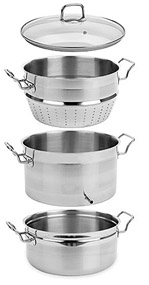
Some may be wondering, “what exactly is a steam juicer?” It can be best described as a double boiler. The steam juicer has three basic parts: a water pan on the bottom, a the juice collector in the middle (shaped like an angle food cake mold), and a perforated produce basket on top.
Water is heated in the pan of the steam juicer. Steam rises through the collector to the produce basket. The steam bursts the skins and extracts the juice. The juice then falls into the collector of the steam juicer and then out the hose.
Using a steam juicer is an effective way to extract juice from fruits like elderberries or plums which have a lot of pulp. The steam juicer breaks down the pulp and extracts the flavor from within the fruit’s fiber making the juice very flavorful.
While the steam juicer has proven to be invaluable to the home winemaker, it is also used for canning, making jellies or just healthier living.
The steam juicer we offer is made of heavy-gauge stainless steel. You can learn more about it by visiting our website.
———————————————————————————————————
Ed Kraus is a 3rd generation home brewer/winemaker and has been an owner of E. C. Kraus since 1999. He has been helping individuals make better wine and beer for over 25 years.
First Steps In Winemaking, One Of The Great Wine Making Books
We offer several different wine making books that go through the process of how to make your own wine. But there’s one that stands out from the rest, First Steps In Winemaking.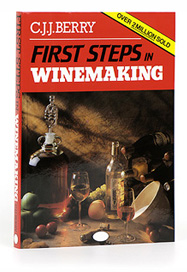
First Steps In Winemaking is one of those wine making books that has the ability to painlessly explain how to make your own wine. It covers all the basics, including the wine making materials you’ll need and gives specific homemade wine instructions.
Wine recipes is another strong point for First Steps In Winemaking. As far as wine making books go this book has a lot of them. In fact, over 120 wine recipes, each with a list of the required wine making materials needed.
In short, First Steps In Winemaking is one of the wine making books that should be on any beginner’s list. It’s clear, concise and does a beautiful job of explaining how to make your own wine.
For more information about First Steps In Winemaking, you can visit the wine making books section of our website.
———————————————————————————————————
Ed Kraus is a 3rd generation home brewer/winemaker and has been an owner of E. C. Kraus since 1999. He has been helping individuals make better wine and beer for over 25 years.
Make Way For Synthetic Corks
Next time you’re ready to buy corks for bottling your wine you might want to take a closer look before you buy. If you do, you’ll discover that a wine bottle cork is not just a wine bottle cork anymore. 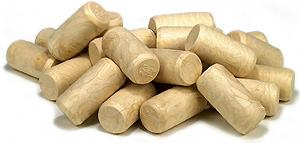
If fact, the natural cork bottle stopper is slowly going to the wayside to make room for other methods of sealing a wine bottle–screw caps being the most evident. But there’s also another not-so-evident alternative to the natural wine bottle cork. They’re called synthetic corks.
Synthetic corks look like a natural wine bottle cork, only they are created from man-made materials. When compared to traditional cork bottle stoppers one easily notices that synthetic corks are heavier and firmer.
This is because synthetic corks are not porous like a traditional wine bottle cork. No air can get through them over time. This makes synthetic corks just as effective for protecting your wine as screw caps, but without the unattractive looks.
The next time you need to buy corks, take a look at synthetic corks. Synthetic corks are an effective alternative to traditional cork bottle stoppers and ideal for protecting your homemade wines.
———————————————————————————————————
Ed Kraus is a 3rd generation home brewer/winemaker and has been an owner of E. C. Kraus since 1999. He has been helping individuals make better wine and beer for over 25 years.
Grape Juice For Wine Making All Year Round
Here at E. C. Kraus we offer a huge selection of wine making products–from tiny packets of wine yeast to large grape presses. We carry it all. But the cornerstone of our offerings is our packaged grape juices.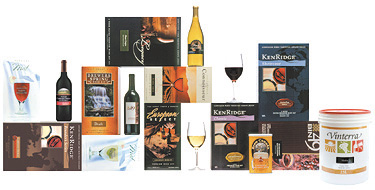
Currently, we have a collection of over 200 different varieties of grape juice for wine making spread over 12 different brands. Juices prepared specifically for making homemade grape wine. And they’re not just available when wine grapes are in season, but all throughout the year.
When you use our grape juices for making wine you are eliminating the need for a grape crusher and a grape press. All that work has already been taken care of for you. The grapes are ran through a grape crusher to create a “must”, and then after the correct amount of time, the pulp is then pressed and packaged for sale.
You also don’t have to bother with hunting down wine recipes either, because one’s included along with the juice. In most cases, all the other wine making products needed like wine yeast are included as well.
So, when it comes to making homemade grape wine from packaged grape juice all this adds up to convenience. Anytime of the year–spring, summer, winter and fall–you can make wonderful homemade grape wine that rivals any winery.
———————————————————————————————————
Ed Kraus is a 3rd generation home brewer/winemaker and has been an owner of E. C. Kraus since 1999. He has been helping individuals make better wine and beer for over 25 years.
Refractometers Let You Know When To Pick
For anyone operating a vineyard, large or small, refractometers are an invaluable tool. They help take the guesswork out of knowing when to pick by indicating when the grapes have become sufficiently sweet–a vital part of any vineyard operation.
Maximizing the sugar level is important, particularly if the grapes are to be used for wine making. Refractometers measure the sugar level (or brix) of the grapes without requiring a large sample size. All the vintner needs is two or three drops of juice from a grape placed on a refractometers prism window, and it will instantly tell him the sugar level of that sample.
This is why refractometers are so important. By simply going randomly throughout the vineyard and testing a few grapes, it can be accurately determined if it is time to pick.
Even though you may only have a few vines and do not have a large vineyard in your backyard, refractometers are still important to you as a home winemaker. Regardless of the size of the batch, you always want to make the best batch you can. And that’s exactly what refractometers help you to do.
We offer a refractometer that is perfect for wine making, and it’s very affordable when compared to some refractometers out there on the market. It comes with its own carrying case, complete with directions and it’s simple to use.
———————————————————————————————————
Ed Kraus is a 3rd generation home brewer/winemaker and has been an owner of E. C. Kraus since 1999. He has been helping individuals make better wine and beer for over 25 years.
Bottling Homemade Wine
When it comes to bottling homemade wine it can be as simple as getting some gallon glass carboys or glass jugs and filling them up with your homemade wine, tighten on a screw cap and store them in the basement. That’s it.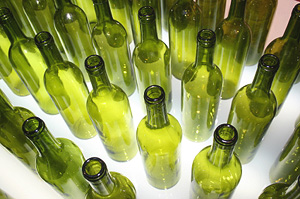
Or, bottling homemade wine can become as complex as: selecting the perfect wine bottle, choosing a shape and color that suites your fancy; selecting a particular wine bottle cork, its length and decorative design printed on the side all being taken into account; choosing wine bottle labels that not only have complimentary colors that “work well” with the wine bottle color, but are custom made with the family’s name a crest prominently displayed. Wow, what a mouth full!
In reality, bottling homemade wine is somewhere between glass jugs and fancy wine labels. When one makes a decision to start making wine from grapes, they needn’t be bothered with such fine details as to what the wine bottle cork has printed on it’s side, but also they shouldn’t be so relaxed as to simply put the wine in glass jugs or a wine carboy and for forget about it.
When bottling homemade wine you need to have a plan, and the plan should be based on wine making knowledge that you receive from wine making books, wine making tips, etc. For example, in neither case above was sodium metabisulfite mentioned even though it is probably the most important thing to take into account when bottling homemade wine.
For more information on bottling homemade wine you may want to take a look at the article, “An Overview Of Wine Bottling” that is listed on our website. This article goes over the issue that really matter when you are bottling homemade wine. For example, it covers the difference in wine bottle cork quality and how this can effect your wine, not what’s printed on the side. This can be a big help when to you when it come down to time to buy corks.
———————————————————————————————————
Ed Kraus is a 3rd generation home brewer/winemaker and has been an owner of E. C. Kraus since 1999. He has been helping individuals make better wine and beer for over 25 years.
